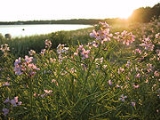
Cakile
Encyclopedia
Cakile is a genus
within the flowering plant
family Brassicaceae
. Species in this genus are commonly known as searockets, though this name on its own is applied particularly to whatever member of the species is native or most common in the region concerned, the European searocket Cakile maritima in Europe, and the American searocket C. edentula in North America. The genus is native to Europe
, Asia
and North America
, but the European searocket has been introduced
into North America and has spread widely on both east and west coasts; in many places it is replacing the native C. edentula, and is regarded as an undesirable invasive species
.
Cakile species grow as perennial plants with an erect or decumbent stem. The common species in Europe and North America grow close to the coast, often in dunes. Their leaves are fleshy. Flowers are typically pale mauve to white, with petals about 1 cm in length; they are rather similar to those of the wild radish
(also in family Brassicaceae) which is found in the same regions, and careful attention to the leaves and stems is needed to tell the two plants apart.
Genus
In biology, a genus is a low-level taxonomic rank used in the biological classification of living and fossil organisms, which is an example of definition by genus and differentia...
within the flowering plant
Flowering plant
The flowering plants , also known as Angiospermae or Magnoliophyta, are the most diverse group of land plants. Angiosperms are seed-producing plants like the gymnosperms and can be distinguished from the gymnosperms by a series of synapomorphies...
family Brassicaceae
Brassicaceae
Brassicaceae, a medium sized and economically important family of flowering plants , are informally known as the mustards, mustard flowers, the crucifers or the cabbage family....
. Species in this genus are commonly known as searockets, though this name on its own is applied particularly to whatever member of the species is native or most common in the region concerned, the European searocket Cakile maritima in Europe, and the American searocket C. edentula in North America. The genus is native to Europe
Europe
Europe is, by convention, one of the world's seven continents. Comprising the westernmost peninsula of Eurasia, Europe is generally 'divided' from Asia to its east by the watershed divides of the Ural and Caucasus Mountains, the Ural River, the Caspian and Black Seas, and the waterways connecting...
, Asia
Asia
Asia is the world's largest and most populous continent, located primarily in the eastern and northern hemispheres. It covers 8.7% of the Earth's total surface area and with approximately 3.879 billion people, it hosts 60% of the world's current human population...
and North America
North America
North America is a continent wholly within the Northern Hemisphere and almost wholly within the Western Hemisphere. It is also considered a northern subcontinent of the Americas...
, but the European searocket has been introduced
Introduced species
An introduced species — or neozoon, alien, exotic, non-indigenous, or non-native species, or simply an introduction, is a species living outside its indigenous or native distributional range, and has arrived in an ecosystem or plant community by human activity, either deliberate or accidental...
into North America and has spread widely on both east and west coasts; in many places it is replacing the native C. edentula, and is regarded as an undesirable invasive species
Invasive species
"Invasive species", or invasive exotics, is a nomenclature term and categorization phrase used for flora and fauna, and for specific restoration-preservation processes in native habitats, with several definitions....
.
Cakile species grow as perennial plants with an erect or decumbent stem. The common species in Europe and North America grow close to the coast, often in dunes. Their leaves are fleshy. Flowers are typically pale mauve to white, with petals about 1 cm in length; they are rather similar to those of the wild radish
Wild radish
Wild Radish or Jointed Charlock, Raphanus raphanistrum, is a flowering plant in the family Brassicaceae. It is sometimes claimed to be the ancestor of the edible radish, Raphanus sativus...
(also in family Brassicaceae) which is found in the same regions, and careful attention to the leaves and stems is needed to tell the two plants apart.

